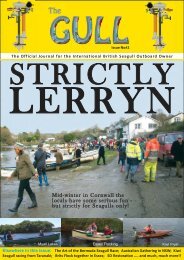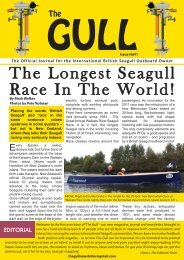FIRST
In the early sixties Kiwi David Lewis and - Saving Old Seagulls
In the early sixties Kiwi David Lewis and - Saving Old Seagulls
- No tags were found...
You also want an ePaper? Increase the reach of your titles
YUMPU automatically turns print PDFs into web optimized ePapers that Google loves.
The Gull<br />
DR DAVID LEWIS - A life well lived<br />
Dr David Lewis is one of those people for whom TE Lawrence (of Arabia) might have written the famous<br />
‘dreamers of the day’ quote from his memoir, Seven Pillars of Wisdom: “Those who dream by night in the dusty<br />
recesses of their minds, wake in the day to find that all was vanity; but the dreamers of the day are dangerous<br />
men, for they may act their dream with open eyes, and so make it possible.”<br />
Born of Welsh-Irish parentage and raised in New Zealand and the Cook Island’s Raratonga, he left New<br />
Zealand to complete his MD in London in 1938, then was drafted into a parachute regiment in WWII.<br />
Family, a busy medical practice and his involvement in the establishment of the National Health Service stymied<br />
his passion for skiing and mountaineering post-war. The collapse of his first marriage led to his participation in<br />
the first OSTAR. The success of the subsequent book, The Ship Would Not Travel Due West, convinced Lewis<br />
he could make a living from writing about sailing and adventuring, which in turn lead to the first multihull<br />
circumnavigation in Rehu Moana - powered by that trusty Seagull 102. The story of the circumnavigation is<br />
contained in the two volumes Daughters of Three Oceans and Children of Three Oceans.<br />
He is perhaps best remembered though for his academic Australian National University-sponsored research<br />
into the navigation skills and practices of early Polynesian navigators, and subsequent voyages in which those<br />
traditional skills were tested and proved, thus expanding the knowledge of the way in which the Polynesian<br />
and Melanesian peoples colonised the Pacific islands.<br />
It also encouraged interest among the Polynesian people themselves, with Lewis being invited to assist on<br />
several subsequent Polynesian ‘navigation adventures’ across the Pacific. Some of those ‘last navigators’ Lewis<br />
encountered and interviewed in the late Sixties were thus encouraged to train another generation of indigenous<br />
navigators in the traditional skills necessary to pilot a vessel without the benefit of charts or compass.<br />
It was this interest, and his absolute belief in the seaworthiness of the ancient double-canoes that undertook<br />
many of the Polynesian migration journeys, that prompted the design of Rehu Moana, the voyage of which in<br />
turn helped spark the multihull revolution of the early seventies.<br />
He later became the first person to sail single-handed to Antarctica, in a voyage that almost took his life, an<br />
experience which prompted him to set up a research foundation that lead small-scale scientific expeditions to<br />
Antarctica and other high latitude destinations that were previously less well-explored.<br />
David Lewis died, aged 85, at Tin Can Bay on the Queensland coast, in 2002, having sailed the east coast of<br />
Australia one final time.<br />
Many of the books of his adventures are still in print and most are widely - and cheaply - available on eBay.<br />
ABOVE: David Lewis aboard Rehu Moana during the intitial shakedown cruise to Iceland, in which the rig broke three times, and the<br />
experimental propulsion plant was replaced by a trusty British Seagull 102 outboard motor, which powered the catamaran on its subsequent<br />
global circumnavigation between 1964 and 1968, becoming as far as is known, the first British Seagull to circumnavigate (as a main engine)<br />
Issue No#3 - March 2012<br />
4





